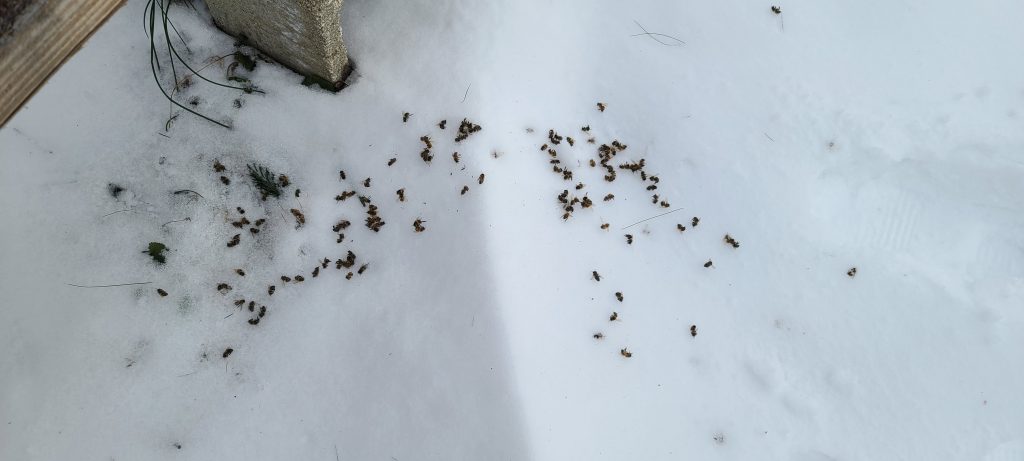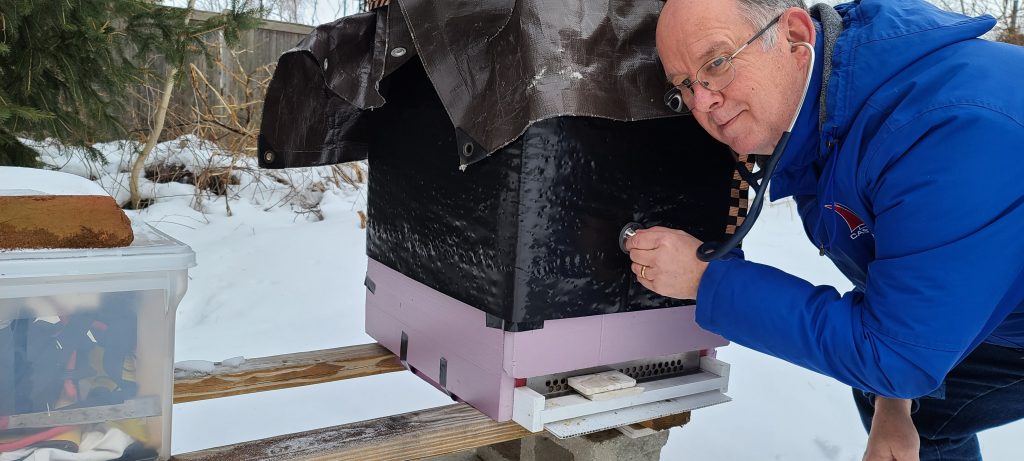I’ve been a beekeeper for a couple of years now. I’ve spent the last two winters worrying about how the bees are doing and trying to find ways to check up on them without having to open the hive and chill all the ladies trying to keep the queen warm. Last year I got pretty creative, as my new beekeeper fears of a super cold winter met up with my addiction to gadgets.
For the 2019-2020 winter, I went out and bought a Broodminder monitor for the hive. I built a heater box for the hive as well, on top of fully insulating the hive. The Broodminder looks like a large leather bookmark and fits between the upper and lower boxes. It gives a pretty continuous readout of the temperature and humidity in the hive to one’s cellphone and to a website. That gave me an idea of how warm the hive was (almost exactly 93F 24/7, regardless of outside temps) but it still didn’t help my concerns about a prolonged cold snap. I’d heard that the year before a lot of hives died off due to super cold weather for days or weeks on end. To address that problem, I built a heater box for the hive. It was a shallow frame under the hive stack, with a shielded red light inside that was controlled by a thermostat. When the temperatures got below 30F it turned the light on until the temperatures reached 35F. On 10F nights it was on all night. It seemed like a great solution that would keep the hive warm but not so warm that the bees would try to fly out into frigid temps.
All that planning and gadgetry came to a sad ending… At the end of the winter, the temperatures in the hive began to drop, as it turned out the bees just didn’t have what it took to survive, heater box or not. I augmented the few hundred remaining bees with a new package this past Spring.
This year I’ve kept it a little simpler. I have two hives now and basically ran out of time to organize all the gadgets. So instead of any technology, I just wrapped the hive in 1″ insulation on the sides and bottom, 2″ inside the cover, a wrap around the whole hive, and a tarp over the top to keep rain from seeping in. (I should mention that I’m using the “hole in a tree” approach to insulation, where there’s no ventilation other than the entrance restrictor. The hive is on a little angle to encourage humidity to fall down the front wall, but that’s about it.)
The problem with this approach is you have to trust that the bees are doing ok. There’s no easy way to see what’s going on other than the regular pile of dead bees on the ground – or on fresh snow.

Rather than open the entire fortified hive up, chill the ladies while I’m seeing if they’re ok, and then hoping they can warm back up quickly, I decided to take an old fashioned approach to check on the hive – just listen to it. However, with a tarp and a wrap and 1″ of insulation and then the wood itself, you can’t just put your ear against the hive and hear anything. Instead, I broke out an old stethoscope I had lying around (you can buy them cheaply online) and used it.

To my delight both hives had the same buzzing sounds I was expecting and, if I trust my ears as I moved around the outside of the hive, the clusters are pretty much in the middle of the hives. It was a relief to me to see (I mean, hear) that wonderful sound of busy bees to offset the few dead bees out front. I cleared the entrance of dearly departed bees and returned home a much happier beekeeper.
